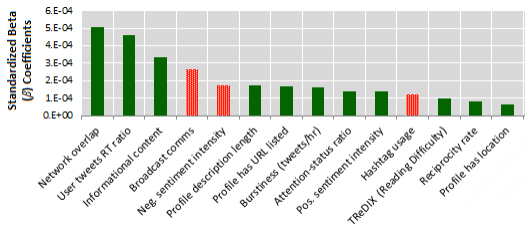“Expressing negative sentiments in tweets is the second most harmful factor to growing a Twitter audience,” say researchers from the Georgia Institute of Technology. They speculate about why: “This might be because Twitter is a medium dominated by very weak social ties, and negative sentiment from strangers may be unpleasant or uncomfortable for a potential new follower to see.”
C.J. Hutto, Eric Gilbert and Sarita Yardi tracked data from over 500 active Twitter users as they tweeted more than 500,000 times in the course of 15 months. The Twitter users were randomly selected from the public timeline over a two-week period, and then screened for requirements like English language, an active account that was at least 30 days old, with at least 15 friends and 5 followers. Hutto elaborated by email:
Although we did nothing to specifically exclude institutional/brand accounts, a quick investigation of a subset of the ~500 users that passed all filters every 3 months indicates these are mostly “everyday” typical non-celebrity users… Very few (if any) are brand or institutional accounts.About every three months the researchers recorded each user’s follower growth, and analyzed what it was about their tweets and behavior that seemed to lead to growth.
They say this is pretty groundbreaking work — “the first longitudinal study of audience growth on Twitter to combine such a diverse set of theory inspired variables” — and it seems so.
Another bit of advice based on the findings: Stop tweeting so much about yourself.
“Informational content attracts followers with an effect that is roughly thirty times higher than the effect of [personal] ‘meformer’ content, which deters growth,” the researchers wrote. “We think this is due to the prevalence of weak ties on Twitter.”
In other words, your Twitter followers don’t know you that well and thus don’t care about what you’re eating. Feed them information instead. Among the accounts studied, users talked about themselves in 41 percent of their tweets while informational content accounted for only 24 percent.
Overall, the study tracks and compares three types of factors — the content of your tweets, the dynamics of your social behavior and the structure of your follower network. Or more simply: What you tweet, how you interact and who you know.
This chart illustrates the statistically significant factors with the biggest impact on follower growth (translated into lay terms in the list below):

- Number of connections in-common with potential new followers (good)
- High frequency of others retweeting your tweets (good)
- High frequency of informational tweets (good)
- Too many “broadcast” tweets not directed at anyone in particular (bad)
- Too much negative sentiment in your tweets (bad)
- A detailed profile description or “bio” (good)
- Profile has a URL listed (good)
- “Burstiness” of your tweets, or the peak rate of tweets-per-hour (more is good; Twitter agrees)
- High ratio of followers to following (good)
- Lots of tweets with positive sentiment (good)
- Cramming too many useless hashtags into your tweets (bad)
- Use of long, fancy words (good)
- Your tendency to follow-back those who follow you (good)
- Profile lists your location (good)
http://www.poynter.org/latest-news/mediawire/205411/science-reveals-what-really-increases-twitter-followers/











